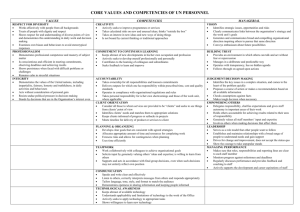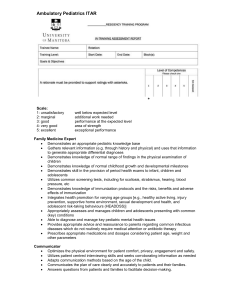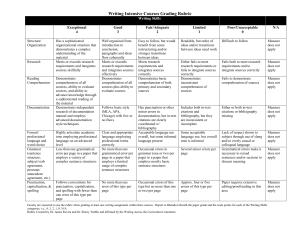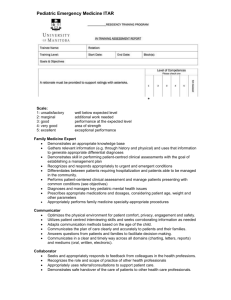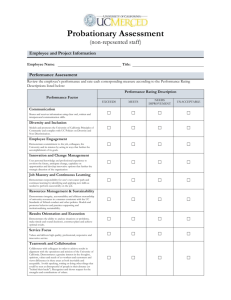Create Ideas and Solutions Rubric pdf editable doc
advertisement
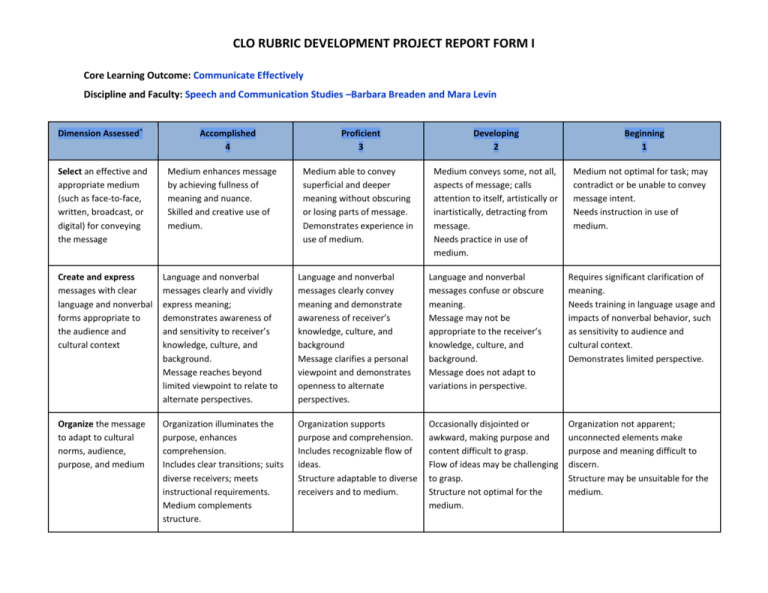
CLO RUBRIC DEVELOPMENT PROJECT REPORT FORM I Core Learning Outcome: Communicate Effectively Discipline and Faculty: Speech and Communication Studies –Barbara Breaden and Mara Levin Dimension Assessed* Accomplished 4 Proficient 3 Developing 2 Medium conveys some, not all, aspects of message; calls attention to itself, artistically or inartistically, detracting from message. Needs practice in use of medium. Beginning 1 Select an effective and appropriate medium (such as face-to-face, written, broadcast, or digital) for conveying the message Medium enhances message by achieving fullness of meaning and nuance. Skilled and creative use of medium. Medium able to convey superficial and deeper meaning without obscuring or losing parts of message. Demonstrates experience in use of medium. Medium not optimal for task; may contradict or be unable to convey message intent. Needs instruction in use of medium. Create and express messages with clear language and nonverbal forms appropriate to the audience and cultural context Language and nonverbal messages clearly and vividly express meaning; demonstrates awareness of and sensitivity to receiver’s knowledge, culture, and background. Message reaches beyond limited viewpoint to relate to alternate perspectives. Language and nonverbal messages clearly convey meaning and demonstrate awareness of receiver’s knowledge, culture, and background Message clarifies a personal viewpoint and demonstrates openness to alternate perspectives. Language and nonverbal messages confuse or obscure meaning. Message may not be appropriate to the receiver’s knowledge, culture, and background. Message does not adapt to variations in perspective. Requires significant clarification of meaning. Needs training in language usage and impacts of nonverbal behavior, such as sensitivity to audience and cultural context. Demonstrates limited perspective. Organize the message to adapt to cultural norms, audience, purpose, and medium Organization illuminates the purpose, enhances comprehension. Includes clear transitions; suits diverse receivers; meets instructional requirements. Medium complements structure. Organization supports purpose and comprehension. Includes recognizable flow of ideas. Structure adaptable to diverse receivers and to medium. Occasionally disjointed or awkward, making purpose and content difficult to grasp. Flow of ideas may be challenging to grasp. Structure not optimal for the medium. Organization not apparent; unconnected elements make purpose and meaning difficult to discern. Structure may be unsuitable for the medium. Dimension Assessed* Accomplished 4 Proficient 3 Developing 2 Beginning 1 Support assertions with contextually appropriate, accurate examples, graphics, and quantitative information Incorporates and attributes sufficient contextually appropriate, creative, ethical, and accurate support for assertions. Incorporates some relevant supportive information, mostly ethical and accurate. Appropriately attributes most, but not all, sources. Includes supportive information, but often asserts claims with weak, limited, or inaccurate support. Needs to attribute sources more consistently. May require instruction in locating and incorporating supportive information and in supporting assertions with examples, graphics, and quantitative information. Attend to messages, check for shared meaning, identify sources of misunderstanding, and signal comprehension or non-comprehension Actively checks perceptions, validates interpretations, and seeks to identify sources of misunderstanding. Signals comprehension while willing to admit non-comprehension Occasionally seeks to validate shared meaning. Able to identify sources of misunderstanding and signal comprehension or noncomprehension Infrequently seeks shared meaning. May resist signaling confusion or non-comprehension Neglects focus on received message. Assumes understanding without validating perceptions or indicating confusion. Demonstrate honesty, openness to alternative views, and respect for others' freedom to dissent Consistently seeks accuracy, demonstrates commitment to honesty. Seeks contradictory information to ensure balanced perspective. Welcomes others’ freedom to dissent Accurately reports information. Able to take another’s perspective. Shows openness, support for alternate views, respect for dissenting positions. Rarely deviates from personal views. Shows some difficulty taking perspective of another. May distort information to bolster own position. Demonstrates attachment to personal views and resists alternatives. May resist or demonstrate disrespect for other’s freedom to dissent. Misrepresents or simplifies information to bolster a personal position.
